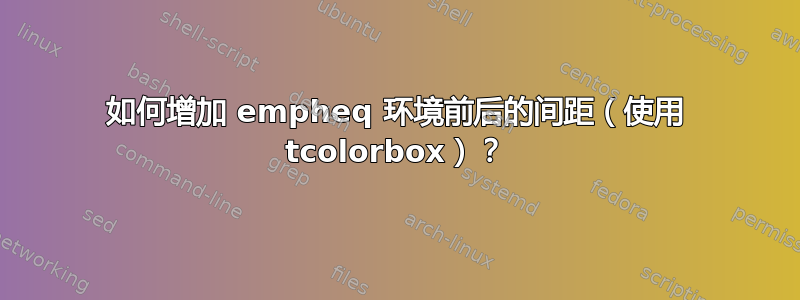
我想问一个问题,如何正确增加 empheq 环境中设置的框前后的间距。这是我使用 LuaLaTeX 编译的 MWE。
\documentclass{scrbook}[DIV=15]
\usepackage{setspace}\setdisplayskipstretch{}
\usepackage{mathtools}
\usepackage{physics}
\usepackage[theorems]{tcolorbox} % Colored boxes
\usepackage{empheq} % Emphasize equations
\tcbset{highlight math style={colback=black!5!white,colframe=black,boxrule=1pt,capture=hbox,arc=0mm,boxsep=0pt}}
\begin{document}
\onehalfspacing
\KOMAoptions{DIV=current}
\chapter{Basic Properties of Numbers}
\section{Laws of Inequalities}
\subsection{Absolute Value and the Triangle Inequality}
The fact that \(-a > 0\) if \(a < 0\) is the basis of a concept which will play an extremely important role in this book. For any number \(a\), we define the \textbf{absolute value} \(\abs{a}\) of \(a\) as follows:
\begin{empheq}[box=\tcbhighmath]{equation*}
\abs{a} =
\begin{cases*}
\phantom{-}a, & if \(a\geq 0\) \\
-a, & if \(a\leq 0\).
\end{cases*}
\end{empheq}
Note that \(\abs{a}\) is always positive, except when \(a = 0\). For example, we have \(\abs{-3} = 3\), \(\abs{7} = 7\), \(\abs{1 + \sqrt{2} - \sqrt{3}} = 1 + \sqrt{2} - \sqrt{3}\), and \(\abs{1 + \sqrt{2} - \sqrt{10}} = \sqrt{10} - \sqrt{2} - 1\). In general, the most straigtforward approach to any problem involving absolute values requires treating several cases separately, since absolute values are defined by cases to begin with. This approach may be used to prove the following very important fact about absolute values.
\end{document}
我尝试使用选项before skip并after skip提供tcolorbox包裹。
\documentclass{scrbook}[DIV=15]
\usepackage{setspace}\setdisplayskipstretch{}
\usepackage{mathtools}
\usepackage{physics}
\usepackage[theorems]{tcolorbox} % Colored boxes
\usepackage{empheq} % Emphasize equations
\tcbset{highlight math style={colback=black!5!white,colframe=black,boxrule=1pt,capture=hbox,arc=0mm,boxsep=0pt,before skip=2.5em, after skip=2.5em}}
\begin{document}
\onehalfspacing
\KOMAoptions{DIV=current}
\chapter{Basic Properties of Numbers}
\section{Laws of Inequalities}
\subsection{Absolute Value and the Triangle Inequality}
The fact that \(-a > 0\) if \(a < 0\) is the basis of a concept which will play an extremely important role in this book. For any number \(a\), we define the \textbf{absolute value} \(\abs{a}\) of \(a\) as follows:
\begin{empheq}[box=\tcbhighmath]{equation*}
\abs{a} =
\begin{cases*}
\phantom{-}a, & if \(a\geq 0\) \\
-a, & if \(a\leq 0\).
\end{cases*}
\end{empheq}
Note that \(\abs{a}\) is always positive, except when \(a = 0\). For example, we have \(\abs{-3} = 3\), \(\abs{7} = 7\), \(\abs{1 + \sqrt{2} - \sqrt{3}} = 1 + \sqrt{2} - \sqrt{3}\), and \(\abs{1 + \sqrt{2} - \sqrt{10}} = \sqrt{10} - \sqrt{2} - 1\). In general, the most straigtforward approach to any problem involving absolute values requires treating several cases separately, since absolute values are defined by cases to begin with. This approach may be used to prove the following very important fact about absolute values.
\end{document}
但它似乎在环境中不起作用empheq。有什么方法可以增加环境前后的间距吗empheq?(\vspace如果可能的话最好不使用。)谢谢。





